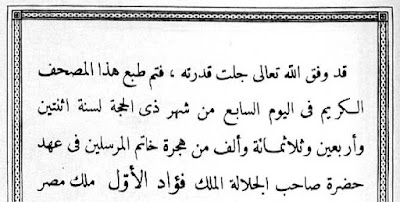Friday, 15 November 2024
KFE <--> kfe
While IDEO held a conference on "100 years of the Cairo Edition" without having a single copy
‒ either of the 1924 edition by al-Ḥusainī al-Ḥaddād nor the 1952 one by aḍ-Ḍabbāʿ & colleagues, neither a big one, nor a small one,
not even a version by a commercial or foreign publisher, just a 1971 print of the 1952 text on 548 pages with 15 lines per page.
Both the Berlin Staatsbiblothek
and Muhammad Hozien
have severval copies.
top image: editions of 1924/5 and 1927, below: both from 1952.
While the Staatsbibliothek was just lucky (getting an intact copy of 1952 with the dedication to King Fuʾād [from East-Berlin] and one in which
the republican bookseller had torn out the page [from West-Berlin]), Muhammad Hozien searched, because he knew that they are not just prints of the same.
1924 to 1952 it is fairly easy:
First comes KFE_1,
then kfe_a, kfe_b, kfe_c
‒ a succession, a development: each edition builds on the earlier one.
When exactely these four editions were published I do not know:
the problem for KFE_1 is objective, for the small ones only subjective (I did not pay sufficient addention).
In all editions up to 1952 one can read:
Printing was finished 7. Ḏul Ḥigga 1342 (= 10.7. 1924).
I have a problem:
How can the book with that text inside know when its printing was finished?
Was it observing its own printing and taking the time?
I guess (!) that the date given was just the date planned,
and because they could not meet it, they decided to stamp the finished book with the real date:
The differences between the editions before 1952 are minor.
My main conclusion from studying the text of 1242/43:
it is not the result of year long committee discussions,
nor the application of what ad-Dānī and Ibn Naǧǧāḥ have written about the rasm,
but a switch form Indian-Persian-Ottoman practise of writing the well established text of Ḥafṣ
to applying the African (Maġribian, Andalusian) rules (without clolour dots, too expensice/complicated for printing at the time).
The text the type setters set &npsp; was written by the chief reader of Egypt, Muḥammad ibn ʿAlī ibn Ḫalaf al-Ḥusainī al-Mālikī aṣ-Ṣaʿīdī al-Ḥaddād (born 1282/1865)
who knew the differences between Warš (of which he had a copy at hand) and Ḥafṣ by heart.
After he had died on 22.1.1939, ʿAlī b. Muḥammad b. Ḥasan b. Ibrāhīm al-Maṣrī aḍ-Ḍabbāʿ became chief reciter of the qurʾān.
He chaired a committee to revise the written text. Apart of one clear mistake (the spelling of /kalimat/ in 7:137), some minor corrections, the elimination of information on the chronology in the sura title boxes, the inclusion of the basmalla in continuous reading (which leads to tanwīn becoming tamwīm at the end of suras 4, 5, 6, 17, 18, 19, 24, 25, 31, 33, 34, 35, 38, 41, 48, 54, 65, 67, 71, 72, 73, 76, 78, 84, 85, 86, 90, 100, 101, 104, 105, 106, and 110)
and about 800 changes in pause signs were decreed ‒ decreed, not made, because the changes were only made in the large editions, for which new plates were manufactured. For the small editions old plates were used, and here some changes were just not made, others by hand. Only the changes in tanwin were all made. (on the image in the middle from the 1954 small edition the sura title box is the old one and the mīm added by hand
below from the Tashkent 1960 reprint.)
so we have: KFE_1 less than 1000 changges in KFE_2 /2a
but: kfe1345, kfe1347 ; less than 100 changes in kfe1371 based on kfe1347 except for the nūn in 73:20
And the changes introduced in kfe1345 and kfe1347 are all gone in KFE_2;
BECAUSE they never occured on the large plates ‒ existing plates were reused.
So, there are technical reasons for the content of the different editions.
While for the Muṣḥaf al-Azhar aš-Šarīf, "the Šamarlī" and the Madina Editions
we have different sizes of the same content,
while we have huge runs of Madina Editions, hence fresh plates (almost) evey year,
the runs of King Fuʾād Editions were low, so low that some of the 1924 plates were used until the end, and some of the first small plates from the next year to the end.
‒
Subscribe to:
Comments (Atom)
Nairīzī
Mirza Aḥmad an-Nairīzī (ca. 1650–1747) is the last of the classical Iranian calligraher s. Informations are hard to find, because often und...

-
40 years ago Adrian Alan Brockett submitted his Ph.D. to the University of St.Andrews: Studies in Two Transmissions of the Qurʾān . Now...
-
There are several types of madd sign in the Qurʾān, in South Asian masāhif: madd al-muttasil for a longer lengthening of the vowel used...
-
Although it is often written that the King Fuʾād Edition fixed a somehow unclear text, and established the reading of Ḥafṣ according to ʿĀ...









